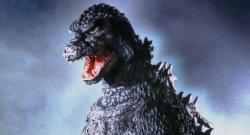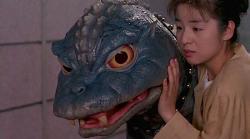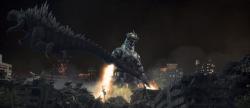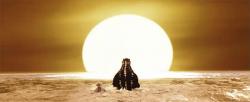Reviews
Godzilla / Gojira / Godzilla 1985
Koji Hashimoto
Japan, 1984
Credits
Review by Rumsey Taylor
Posted on 16 February 2013
Source DVD
Categories The Compleat Godzilla
Between its inception and initial hiatus, the Godzilla franchise had lasted long enough to exploit seemingly every facet of the kaiju genre. By the onset of the 1980s it had produced fourteen films that host over fifty creatures, many of which Godzilla had bravely confronted with diminishing returns in profit. What was once so despairing and serious a depiction of nuclear warfare paranoia became cartoonish and gaudy, and after 1975’s Terror of Mechagodzilla it would be nine years before Godzilla would again be seen in theaters.1
This absence would lend the franchise a curious prescience due to the political climate of the 1980s, in which Cold War paranoia resuscitated and pronounced the very fears that motivated the Godzilla films thirty years prior. The series was regenerated in 1984’s Godzilla, colloquially referred to as The Return of Godzilla, a direct continuation of the 1954 original that decidedly omits all of the sequels and spinoffs in an effort to reassert the series’ utility as metaphor.
In his initial incarnations, Godzilla was a moving statue whose threat was more sufficiently articulated in the images of the aftermath of his havoc: a gigantic radioactive footprint, or a path of destruction set aflame long after the beast returned to the sea—the latter of which evokes images of Hiroshima’s bombing. This is the economic conceit of a Godzilla movie, that Godzilla relays threat more than he personifies it, but in the later films he’s promoted over the evidence of his destruction. He’ll wrestle with greater prowess and, in one memorable instance, dance, and the filmmaking does little to conceal his physical inhibition. He looks more and more like a spectacular halloween costume instead of a prehistoric beast, and this engenders Godzilla as an object of sympathy because he is so clearly anthropomorphized. In result, even though he was a continually untenable urban threat, he would grow increasingly more humane. He would begin to be seen in closeups, his goofy countenance a pair of static eyes that bulge out from his head like a frog’s and tilt downward like a jack-o-lantern’s; but in Return, they are set fiercely in his head and relay a grimace, above a snout that curls fearsomely into an enormous growl, one that reveals two opposed rows of very sharp, very large teeth. Whatever humanity Godzilla had inherited over the course of his career is in this film dispensed with, and he emerges again, monstrous and alone, from the Pacific Ocean with those terrible eyes fixed mercilessly upon Tokyo’s horizon.
From here The Return of Godzilla proceeds along much the same course as its 1954 predecessor, although a particular continuity is established. In a scenario repurposed from the first film, a fishing boat encounters an underwater radioactive surge that leaves its occupants dead. When a journalist visits the wreckage he faces a bloodthirsty, eyeless reptile that turns out to be a prehistoric parasite—one, locals speculate, that otherwise feeds off Godzilla, who has been asleep at the bottom of the Pacific since his last rampage. Given the outcry it caused then the threat of another attack leaves local authorities hesitant to announce it publicly. Nevertheless, the beast’s thunderous footsteps are enough of a beacon, and in this film his resolve is clearer. He marches up an island that possesses a nuclear reactor, reaches in and extracts its electronic heart—this action charges Godzilla like a battery, and his tail fins buzz electrically. Nourished, he proceeds en route to Tokyo.
However armed with the memory of his destruction thirty years prior, Tokyo’s authorities are arguably no better equipped to subdue the behemoth. There is no oxygen bomb - the on-the-fly solution to killing him in the 1954 film - but there is the Super X, a man-made UFO that emits lasers that antagonize and temporarily subdue Godzilla. Furthermore, both the Russians and Americans are imperatively game to launch nukes in an effort to isolate Godzilla’s attacks to Japan.
Whereas 1954’s Godzilla was rife with suspense, for the populace witnesses Godzilla’s destruction without anticipation, the 1984 incarnation elaborates upon bombast of the original. Taken as an effort to reassert Godzilla as both a nuclear threat and a giant monster, it is perhaps Toho’s most sinister outing at the time of its release, but it does not sidestep all the tropes that had increasingly diminished the franchise’s quality: the human characters and their plights are fundamentally secondary, and the narrative is expressly intent to satisfy the need for Godzilla to face big, destructive forces; any human drama as a ballast to this remains principally insignificant.
As the Godzilla series progressed through the ’60s and ’70s, its appeal would grow broader and more kid-friendly (in their International versions, the Godzilla films were often edited to obtain G-ratings, which sometimes compromised their otherwise hostile political scenarios). They would feature more bombastic and cartoonish narratives which would dilute the environmental paranoia that founded the series in the first place. Taken as a response to these trends, The Return of Godzilla is comparably darker and more sophisticated than most all of its predecessors, and although it does not fully transcend the series’ perennial faults it ably sets a standard for its remainder.
- This is not to mention the series’ Hanna-Barbera animated spinoff from 1978. ↩
More The Compleat Godzilla
-

Godzilla
1954 -

Godzilla Raids Again
1955 -

King Kong vs. Godzilla
1962 -

Mothra vs. Godzilla
1964 -

Ghidorah, the Three-Headed Monster
1964 -

Invasion of Astro-Monster
1965 -

Ebirah, Horror of the Deep
1966 -

Son of Godzilla
1967 -

Destroy All Monsters!
1968 -

All Monsters Attack
1969 -

Godzilla Vs. Hedorah
1971 -

Godzilla vs. Gigan
1972 -

Godzilla vs. Megalon
1973 -

Godzilla vs. Mechagodzilla
1974 -

Terror of Mechagodzilla
1975 -

The Return of Godzilla
1984 -

Godzilla vs. Biollante
1989 -

Godzilla vs. King Ghidorah
1991 -

Godzilla vs. Mothra
1992 -

Godzilla vs. Mechagodzilla
1993 -

Godzilla vs. SpaceGodzilla
1994 -

Godzilla vs. Destoroyah
1995 -

Godzilla 2000
1999 -

Godzilla vs. Megaguirus
2000 -

Godzilla, Mothra and King Ghidorah: Giant Monsters All-Out Attack
2001 -

Godzilla Against Mechagodzilla
2002 -

Godzilla: Tokyo S.O.S.
2003 -

Godzilla: Final Wars
2004
We don’t do comments anymore, but you may contact us here or find us on Twitter or Facebook.



